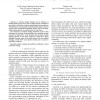Free Online Productivity Tools
i2Speak
i2Symbol
i2OCR
iTex2Img
iWeb2Print
iWeb2Shot
i2Type
iPdf2Split
iPdf2Merge
i2Bopomofo
i2Arabic
i2Style
i2Image
i2PDF
iLatex2Rtf
Sci2ools
ICST
2010
IEEE
2010
IEEE
Satisfying Test Preconditions through Guided Object Selection
—A random testing strategy can be effective at finding faults, but may leave some routines entirely untested if it never gets to call them on objects satisfying their preconditions. This limitation is particularly frustrating if the object pool does contain some precondition-satisfying objects but the strategy, which selects objects at random, does not use them. The extension of random testing described in this article addresses the problem. Experimentally, the resulting strategy succeeds in testing 56% of the routines that the pure random strategy missed; it tests hard routines 3.6 times more often; although it misses some of the faults detected by the original strategy, it finds 9.5% more faults overall; and it causes no noticeable overhead. Keywords-random testing; precondition satisfaction; linear constraint solving
| Added | 26 Jan 2011 |
| Updated | 26 Jan 2011 |
| Type | Journal |
| Year | 2010 |
| Where | ICST |
| Authors | Yi Wei, Serge Gebhardt, Bertrand Meyer, Manuel Oriol |
Comments (0)

